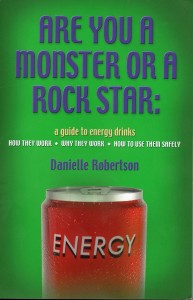Book Review: Are You a Monster or a Rock Star: A Guide to Energy Drinks by Danielle Robertson
Disclaimer: I received this book in a Goodreads giveaway on the premise that I would review it. The book itself has an extensive disclaimer that it is not a substitute for consultation with a licensed healthcare professional.
Like many people, I have sampled energy drinks from time to time, and heard scary things about their possible health effects. This book by a food biochemist and dietitian seeks to inform the reader about these liquids. It’s explained that “energy drinks” includes both beverages and supplements, which are similar in nature, but regulated differently. (For example, ginko biloba is not allowed as a beverage ingredient, but is allowed in supplements.)
After a brief history of energy drinks, starting with Thailand’s Krathing Daeng, the ancestor of Red Bull, the book has a section on the safety of these liquids. It mentions Adverse Event Reports (do not mix energy drinks and alcohol, it’s a killer), biological sensitivity and consumption practices.
This is followed by a section on how energy drinks do (and don’t) work. This includes bits on how your individual circumstances may change the effectiveness.
The largest section goes into detail on each major active ingredient; what it does, where else you can get it, and what happens if you get too little or too much. This runs the gamut from caffeine through vitamin B12 to Yerba Mate. Some ingredients have not been proven to do anything other than sound cool, others can be dangerous if you get too much.
There are appendixes on: ways to wake up without caffeine, the stages of fatigue and which type of products work best at each level (note: this book does not endorse any specific brand of energy drink), how the FDA handles Adverse Event Reports, the American Beverage Association’s code for responsible labeling and marketing practices, and definitions of some terms. There’s also a list of references in the back for more research.
This book is aimed at the layperson, with simple metaphors and relatively plain vocabulary. With the help of your healthcare provider, you can use this book to see if an energy drink will be safe and effective for your particular situation. I’d recommend this book to users of energy drinks, and students majoring in dietetics or food biochemistry. It’s clearly written and has many interesting facts.

